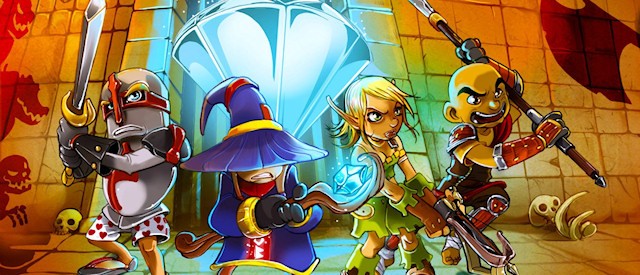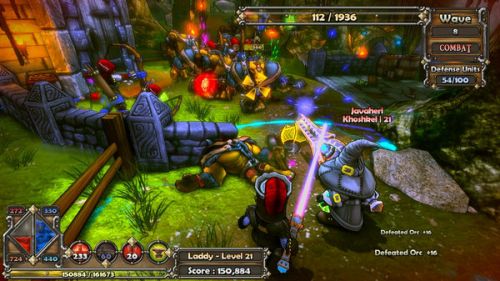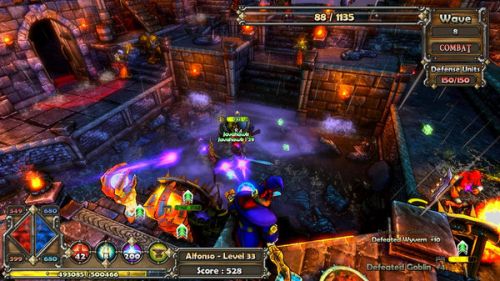

Dungeon Defenders: First Wave for mobile platforms was a decent success, if you could access it. Eventually it became free to play title with the option to purchase in-game mana via microtransactions. Now updated to the Second Wave, it is still popular among the mobile players and it even interconnects with the PC version in cross platform co-op.
Alas, my quite powerful HTC phone is not fully supported. I can download the game and play in the Tavern (a small, free-roam staging area), but loading a mission causes a critical crash. So imagine the sneer that crept across my face each time someone chatted up Dungeon Defenders and its latest, awesome trailer. Yeah, knock yourself out, buddy. I was an early adopter and still haven’t gotten to actually play the game.
But a second chance was written in the stars; I’d signed myself up for review duty months before. With a sinking feeling that I was going to either have to swallow my pride or justify my bitterness I fired up the Xbox 360 version of Dungeon Defenders.

The first thing you’ll notice is how campy this game is. The characters are partially cel-shaded and each have their own twist on their respective genres - a pantless knight (Squire), a bouncy-chested elf (Huntress), a levitating Monk, and a mage with an obscured face and oversized hat (Apprentice) are your hero choices. Each have a primary attack type and a handful of unique traps that are unlocked as you level up. These traps and abilities cost mana to use, which you earn by killing enemies while protecting your crystal from attack.
The second thing you’ll notice is how slow the pacing is as a level 0 character. This was disconcerting at first, but after dumping several pips into my character’s speed I was finally able to put the “action” into “action RPG”. Granted, this game is supposed to be a tower defense hybrid - and so the slower, methodical pace is warranted - but nonetheless I was not a fan of the first 30 minutes of solo play.
After getting some faster legs on Sir Jim I bought some upgraded armor and a better sword in the Tavern. The loot system in Defenders is a lot of fun for novice RPG players, because it’s very generous and easy to understand. Whomever can’t be bothered by looking at every individual stat can instead let the game decide which pieces are best to equip - a thumb up or down icon provides quick and simple suggestion. Building defense mechanisms and traps is done by using a four-position radial menu. It’s not complicated, but taking any damage kicks you back out to the main screen. To counter this there’s a build phase before every round, and if you need to quickly repair something there is a shortcut button so you can avoid getting caught in the radial menus. It’s not perfect, but it works.

The next step in my exploration was getting online. The fluidity of getting from the main menu into a game of four players exceeded my expectations. Not only is matchmaking quick and simple, I didn’t notice any in-game lag. You can join a random game, start a public match, or start a private (invite-only) match. But the real treat is being able to drag friends in with you. There are no excuses not to - only one Live Gold account is needed on the Xbox version, and the rest can play as guests. What’s more is that they can each create characters that are saved to that Live account for future use. As four-player co-op games go, it’s probably the most accessible and easy-to-begin game I’ve played this year...maybe ever. My experience with the XBLA version has been a far cry better than that of the mobile version.
After completing the game’s campaign there’s a challenge mode which further deepens the experience, asking players to complete maps in certain ways - like without towers. Beyond that there’s also an option to turn any map into a survival mode - obviously best experienced with friends in co-op.
Local co-op is played splitscreen, and when playing with only two players you are given the option to split the screen horizontally or vertically. If the interface doesn’t fit your fancy, you can also resize it - a really nice touch.
The tavern area I mentioned earlier also makes a return as an area to socialize, sell excess items, and buy unique goods like pets for your character as well as armor and weapons. From here you can also access your stats and launch one of the game’s missions. You can even sort of trade items between players by dropping items. You can even test out your weapons and defenses against a little attack dummy that sits in the corner. It’s a great way to see exactly how much damage an upgraded cannon turret does before dropping it in the heat of battle.
All in all, it’s an addictive game with a lot going for it. It’s easy to play, and just requires some patience to get used to the busy visuals and slow-to-moderate pacing. It offers an incredible range of depth, providing enough to keep hardcore RPG players interested but also using simple references so that the appeal is not lost on casual players.
And as a side note - while writing this review I’ve successfully updated Dungeon Defenders: Second Wave to my Android phone and it seems to have the bugs worked out. My tale of woe has a happy ending after all. Next year's PlayStation Vita version of Dungeon Defenders is as good as bought, in my book.
This review is based on the Xbox 360 and PC version of the game.